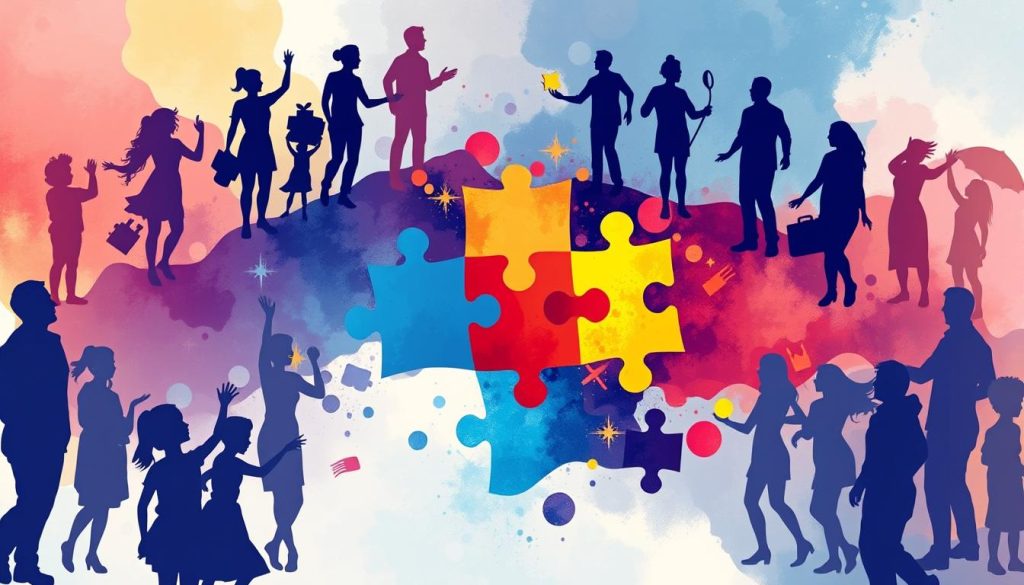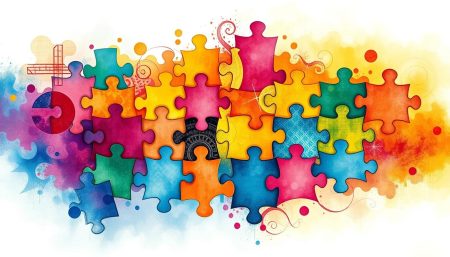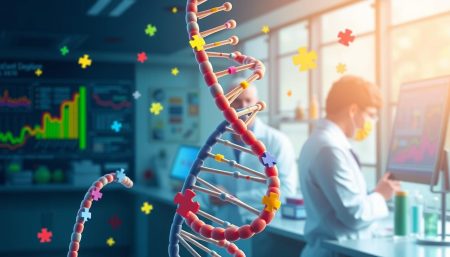Autism Spectrum Disorder (ASD) is more than just a term; it’s a reality for millions every day. The Centers for Disease Control and Prevention (CDC) say 1 in 54 kids in the U.S. have autism. This shows how common it is in our communities.
ASD is a developmental disability that has sparked a lot of autism awareness. It’s making us all understand autism better. The spectrum of ASD is wide, with challenges like social issues, limited interests, and repetitive behaviors.
But, there’s hope. Early diagnosis and timely help can greatly improve life for those with ASD. is changing, and so is how we support and accept those on their ASD journey.
What Is Autism Spectrum Disorder (ASD)?
Autism Spectrum Disorder (ASD) is a complex condition that affects how people interact, communicate, and behave. It’s important to understand ASD early to help those affected. This understanding can lead to better ways to help them.
Defining Autism Spectrum Disorder
The American Psychiatric Association’s DSM-5 defines ASD. It says ASD causes challenges in social interactions and repetitive behaviors. These issues start in early childhood and impact daily life.
The Spectrum: From Mild to Severe
ASD symptoms vary greatly from person to person. Some need a lot of help with daily tasks, while others can live independently but may have subtle signs of ASD.
Prevalence and Demographics
Studies show autism affects all ethnic and socioeconomic groups. It’s more common in boys than girls. This highlights the need for broad awareness and accurate diagnosis.
| Category | Prevalence | Notes |
|---|---|---|
| Ethnic Groups | All groups affected | No significant difference in occurrence between ethnicities |
| Gender | Higher in boys | Boys are approximately 4 times more likely to be diagnosed than girls |
| Age of Diagnosis | Typically by age 4 | Early diagnosis can lead to better outcomes |
History and Evolution of Autism Understanding
The journey to understand autism has seen big steps and new discoveries. The word autism was first used by Eugen Bleuler in 1911. It was linked to schizophrenia back then. Looking into autism history shows how we’ve moved from wrong ideas to a better understanding.
In the mid-20th century, autism research really took off. The 1940s were key when Leo Kanner and Hans Asperger described autism as its own condition. This was a big change, starting a lot of research and debate about autism.
- The early link to schizophrenia showed how confused people were about autism.
- Leo Kanner and Hans Asperger worked separately but both highlighted autism’s unique traits. Kanner focused on emotional and social issues, while Asperger noted the special talents of his patients.
Asperger’s syndrome was once seen as different, but now it’s part of the autism spectrum. This change shows how autism research keeps growing and changing with new discoveries.
| Year | Discovery | Impact |
|---|---|---|
| 1911 | Introduction of the term ‘Autism’ | Started studying autism in mental health |
| 1940s | Separate identification by Kanner and Asperger | Started the modern view of the autism spectrum |
| 1990s | Integration of Asperger’s into the autism spectrum | Expanded ASD, showing a range of symptoms |
The shift from seeing autism as a form of psychosis to a spectrum of conditions is huge. It’s changed how we diagnose and help people with autism, showing a big change in autism history.
Signs and Symptoms of Autism
Spotting autism signs and symptoms is key for early help and support. Knowing these signs helps in early diagnosis. It also lets caregivers and professionals offer the right help.
Early Indicators in Children
Spotting autism early is very important. Look for signs like not making eye contact, not responding to their name by 12 months, and speech delays. Catching these signs early can greatly help a child’s development.
Behavioral and Social Symptoms
As kids get older, autism signs become more obvious. They might struggle to share feelings, understand social cues, and make friends. Seeing these signs helps plan for social skills training and therapy.
Communication Challenges and Patterns
Children with autism often face communication hurdles. They might talk late or have trouble keeping conversations going. Some might repeat words or sounds without meaning to. Spotting these signs is key to better communication help.
How Autism Is Diagnosed
The autism diagnosis process involves several key steps. It requires the work of many healthcare professionals. Knowing about this process helps raise autism awareness and ensures early developmental screening and help.
Developmental Screening: This early check is key in finding autism spectrum disorder (ASD). Doctors use tests and questionnaires during visits to watch a child’s growth. These screenings are very important if a child shows signs of ASD or has a family history of it.
Comprehensive Diagnostic Evaluations: If a screening suggests ASD, a deeper look is needed. A team of experts, like psychologists and speech therapists, do this. They watch how the child acts and talks, and how they interact with others.
No single test can say for sure if a child has autism. The diagnosis comes from watching how the child talks and acts. Starting early help, even at 18 months, can change a child’s path a lot.
Talking about how autism is diagnosed helps parents and caregivers. It also helps spread the word about autism. Here’s how different professionals help figure out if a child has ASD:
| Specialist | Role in Autism Diagnosis |
|---|---|
| Developmental Pediatrician | Leads initial screenings, oversees medical and behavioral evaluations |
| Child Psychologist | Assesses behavioral and cognitive development |
| Psychiatrist | Evaluates emotional and behavioral health, prescribes medication if needed |
| Speech Therapist | Examines communication skills and provides targeted interventions |
| Occupational Therapist | Assesses developmental milestones and fine motor skills |

Common Misconceptions About Autism
Many autism myths and autism stereotypes are out there, affecting how people see autism spectrum disorder ASD. It’s important to clear up these wrong ideas. Doing so helps both the well-being of those with autism and how society views them.
Dispelling Autism Myths
One big myth is that vaccines cause autism. Many studies have shown this is not true, but it’s a worry for many parents. Another myth is that people with autism don’t feel emotions. But, they might show feelings in different ways, leading to misunderstandings.
Some think all autistic people have special talents. While some do, many face different challenges and abilities. It’s key to see the variety within the autism spectrum.
The Impact of Stereotypes on ASD
Autism stereotypes shape how people see living with ASD. Stereotypes saying autistic people can’t have jobs or relationships hurt their chances in these areas. It’s vital to break these stereotypes to open up more possibilities for autistic individuals.
These stereotypes also affect policies and education. They can either help or hinder the inclusion of people with autism, depending on the accuracy of the information.
| Myth | Reality |
|---|---|
| Vaccines cause autism | No credible scientific study supports this claim. |
| People with autism don’t feel emotions | Individuals with autism may experience and express emotions differently. |
| Autistic individuals have savant skills | Some may have exceptional abilities, but this is not the norm for everyone on the spectrum. |
| Autism prevents forming relationships | Many individuals with autism form deep, meaningful relationships, though they might interact in ways that vary from societal norms. |
Autism Spectrum Disorder ASD in Daily Life
Living with autism means getting the right autism support and autism therapy. People with autism face special challenges. They need specific help and changes in their world to do well.
Having set routines is key. They help manage stress and improve daily functioning. Sensory issues also matter a lot. Things like clothes texture and light brightness can really affect how comfortable and focused someone is.
- Consistent schedules reduce anxiety by providing predictable and safe parameters within which they can operate.
- Personalized sensory-friendly zones help in managing sensory overload, which is vital for staying focused and feeling good.
Good support for autism means understanding and making changes that meet the person’s needs. This includes special learning methods, communication tools, and spaces that are easier on the senses.
| Aspect | Importance | Example of Support |
|---|---|---|
| Structured Routines | Helps in reducing stress and improving predictability | Visual schedules, alerts for different activities |
| Sensory Adaptations | Crucial for comfort and effective interaction with environment | Noise-canceling headphones, soft lighting |
| Communication Assistance | Supports successful and less stressful interactions | Pictorial aids, speech therapy |
With the right support, many people with ASD can live happy lives. This not only helps them but also adds to society with their unique views and contributions.
Therapeutic Approaches for Autism
Autism therapy uses many strategies to meet the needs of those with autism. It includes behavioral therapy, ways to improve communication, and occupational and physical therapies. Each is designed to help in different areas of development.
Behavioral Therapies and Interventions
Behavioral therapy is key in autism treatment. It uses Applied Behavior Analysis (ABA) to improve behaviors and skills. ABA uses rewards and support to help individuals with ASD.
This therapy is important for bettering daily life and skills. It helps people with ASD live more independently and happily.
Communication Development Strategies
Improving communication is a big part of autism therapy. It uses speech therapy and assistive technologies. These tools help people with ASD talk better and connect with others.
Occupational and Physical Therapy for ASD
Occupational therapy helps with motor skills and sensory integration. Physical therapy boosts strength and coordination. Both are key for daily independence and better motor skills.
| Type of Therapy | Focus Area | Expected Outcome |
|---|---|---|
| Behavioral Therapy | Behavior Modification | Improved social skills, reduced behavioral issues |
| Communication Therapy | Speech and Language | Enhanced communication skills |
| Occupational Therapy | Motor Skills and Sensory Integration | Increased independence in daily activities |
Autism and Educational Settings
Understanding the different educational settings for kids with autism is key. It shows how important inclusion, special education, and good autism education are. These options help meet various needs and aim for educational success.
- Inclusion in Mainstream Classrooms: This approach puts students with autism in regular classrooms. They get help from aids and special resources. This helps them improve socially and academically.
- Specialized Schools: These schools have special programs and therapies for autism. They offer a safe place for those needing more help.
- Home-based Education: For some, learning at home works best. Here, parents or tutors can tailor education to fit the child’s needs.
Individualized Education Programs (IEPs) are key. They outline what a child needs in school. Teachers, therapists, and parents work together to make these plans. They aim to support all parts of a child’s growth.
Teachers and school staff need training to understand and support kids with autism. Keeping up with new knowledge helps them use the best teaching methods.
| Education Settings | Features | Benefits |
|---|---|---|
| Inclusive Classrooms | Integration with peers, specialist support | Boosts social skills, promotes empathy among peers |
| Specialized Schools | Customized curricula, therapeutic interventions | Focused support, controlled environment |
| Home-based Education | One-on-one tutoring, flexible scheduling | Personalized approach, comfortable setting |

The main goal in all these settings is the same. It’s to improve education and personal growth for students with autism. This is done through special education and inclusion strategies tailored just for them.
The Role of Family in Autism Support
Family plays a key role in supporting individuals with autism. They offer emotional comfort and help access important autism resources. With family support, families can better handle the challenges of autism.
Support Networks and Resources for Families
For families dealing with autism, joining support networks is very helpful. These networks provide guidance, workshops, and a community of support. They give families the tools and help they need to support their loved ones well.
- Social interaction groups for building communication skills
- Educational programs tailored to family needs
- Advocacy and legal assistance
Navigating Relationships and Family Dynamics
Autism impacts not just the individual but also family dynamics. It’s important to understand and adjust to these changes. Open communication and support can help families cope better, creating a caring environment for everyone.
Using external resources and family therapy is key. They offer strategies for family support.
In summary, family support, along with autism resources and networks, is vital for caring for individuals with autism. Seeking out and using these resources can greatly improve family life.
Autism in the Workplace
More businesses are now embracing autism workplace inclusion. They are providing employment for autistic adults. This not only supports a diverse workforce but also brings unique talents and perspectives. It enhances organizational performance and innovation.
Key to successfully incorporating individuals with ASD into the workplace are tailored accommodations. These include structured workflows, detailed job descriptions, and environments that meet sensory needs. Clear and consistent communication strategies are also vital. They ensure autistic employees have the tools to succeed and excel in their roles.
- Structured environments that reduce sensory overload
- Detailed job descriptions and expectations
- Clear communication and feedback methods
- Access to support and mentoring programs
| Benefit | Impact on Workplace |
|---|---|
| Diverse skill sets | Enhances problem-solving and innovation. |
| Detail-oriented perspectives | Improves quality and accuracy of work. |
| Inclusive culture | Boosts overall employee morale and engagement. |
| Reduced turnover | Increases retention through heightened loyalty. |
Employment for autistic adults and initiatives promoting autism workplace inclusion provide meaningful opportunities. They significantly contribute to inclusivity and diversity. Such initiatives transform workplaces into models of inclusivity, setting a benchmark in the corporate sphere.
Current Autism Research and Future Directions
Autism research is constantly growing, with big steps forward in many areas. New tech helps us diagnose better, and we’re finding genetic clues. We’re also working on new treatments for autism. Each part helps us understand and help people with autism more.
Technological Advancements in ASD Research
New tech has changed how we study autism. High-tech imaging and data tools let us see brain details like never before. This helps us find autism early and create treatments that fit each person’s needs.
The Search for Genetic Markers
Finding genetic clues is key in autism research. Scientists are finding genes linked to autism. This helps us understand how autism starts and find risk factors. It also means we can diagnose and treat earlier.
Developing New Therapeutics and Interventions
New treatments for autism are coming fast, with a focus on helping people communicate and socialize better. These treatments aim to improve life for those with autism. It’s important to keep working on these to help more people.
| Focus Area | Technological Advancements | Genetic Research | Therapeutic Development |
|---|---|---|---|
| Key Component | High-resolution imaging | Gene identification | Behavioral and biomedical treatments |
| Impact | Enhanced diagnostics and personalization | Risk assessment and early detection | Improved quality of life |
| Goal | Refine intervention strategies | Understand ASD mechanisms | Address diverse needs effectively |
The Importance of Autism Awareness
Increasing autism awareness is key to creating a society where people with autism can succeed. By focusing on education and outreach, we aim to better understand autism. This understanding is vital for breaking down barriers and helping people with autism fit in.
Autism Awareness Month in April is a big push for change. It’s when groups work together to spread the word about autism. They aim to change how communities and laws treat people with autism.
Autism Awareness Month shines a light on the autism community. It’s a time for everyone to come together. They work to make society more accepting of autism.
More people knowing about autism makes a big difference. It helps improve how we support those with autism. It also leads to better decisions from lawmakers, giving more resources to autism support.
| Focus Area | Goal | Outcome |
|---|---|---|
| Public Education | Enhance General Understanding | Better Social Inclusion |
| Policy Advocacy | Influence Change | Improved Support Structures |
| Community Engagement | Increase Participation | Stronger Community Networks |
The efforts to raise awareness about autism are vital. They help create a world where people with autism are accepted. Every conversation and every policy change brings us closer to a society that welcomes everyone.
Legal Rights and Protections for Individuals with Autism
It’s important to know the legal rights and protections for people with autism. The Americans with Disabilities Act and the Individuals with Disabilities Education Act help protect these rights. They make sure everyone is treated fairly.
Understanding the Americans with Disabilities Act
The Americans with Disabilities Act (ADA) is key. It stops people with disabilities from being treated unfairly. It makes sure those with autism have the same chances in work, school, and public places.
Education and the Individuals with Disabilities Education Act
The Individuals with Disabilities Education Act (IDEA) helps kids with autism. It makes sure they get a good education in a place that fits them best. It also means their education plans are made just for them.
| Act | Focus Area | Key Provision |
|---|---|---|
| Americans with Disabilities Act | Employment, Public Services, Accessibility | Prohibits discrimination and ensures equal opportunities in major public domains |
| Individuals with Disabilities Education Act | Education | Ensures access to specialized educational plans suited to individual needs |
These legal rights are more than just protection. They give people with autism the power to be part of society. They help everyone see the value of diversity and unique abilities.
An Overview of Autism Symptoms and Management
Autism Spectrum Disorder (ASD) brings different challenges to each person. It affects how they interact, communicate, and behave. People with autism might struggle with social cues, prefer the same activities, or use different ways to communicate.
Understanding these symptoms is key to seeing how ASD impacts each person. It helps us see how they interact with the world.
Effective autism management means tailoring support to each person’s needs. This might include therapies like Applied Behavior Analysis (ABA), educational support, and making daily environments more accessible. The goal is to help each person use their strengths and get support where needed.
Using a personalized approach can really change someone’s life. It helps people with autism develop ways to cope, improve social skills, and learn better. This approach makes society more inclusive and values the unique talents and views of those with autism.
FAQ
Q: What is Autism Spectrum Disorder (ASD)?
A: Autism Spectrum Disorder (ASD) is a complex condition. It affects social skills, speech, and communication. Symptoms vary, so it’s called a spectrum.
Q: How prevalent is Autism Spectrum Disorder?
A: The CDC says 1 in 54 kids in the U.S. have ASD. It affects all kinds of people, more in boys than girls.
Q: What are the early signs of Autism in children?
A: Early signs include not making eye contact and not responding to their name. Also, delayed speech is a sign. Parents should watch for these and seek help if they see them.
Q: How is Autism diagnosed?
A: Doctors use screenings and evaluations to diagnose ASD. They look at a child’s behavior and development. There’s no single test for autism.
Q: What common misconceptions exist about Autism?
A: Some think vaccines cause autism, which is not true. Others believe people with autism don’t feel emotions. These myths are wrong and hurt people with ASD.
Q: How does Autism affect daily life?
A: People with ASD might need routine and support. They can be sensitive to sounds and touch. But, with the right help, they can live happy lives.
Q: What therapeutic approaches help manage Autism?
A: Therapies include ABA, speech therapy, and physical therapy. These help with communication, motor skills, and sensory issues.
Q: How do educational settings accommodate students with Autism?
A: Schools offer different settings based on a child’s needs. They have IEPs for support and accommodations. This helps students with ASD succeed.
Q: How do families support a family member with Autism?
A: Families offer emotional support and help with advocacy. They use resources and support groups. This helps them navigate the challenges of ASD.
Q: What is the importance of Autism workplace inclusion?
A: Inclusive workplaces value the talents of people with ASD. They provide accommodations. This benefits everyone, not just those with ASD.
Q: What are some current focuses of Autism research?
A: Research looks at new technologies and genetic markers. It aims to find better treatments and interventions. This helps meet the needs of individuals with ASD.
Q: Why is Autism Awareness important?
A: Awareness promotes understanding and acceptance. It leads to more support and inclusion. It also drives policy changes and better resources for ASD.
Q: What legal protections exist for individuals with Autism?
A: The ADA and IDEA protect individuals with autism. They ensure non-discrimination and access to education. These laws are important for rights and support.
Q: Can individuals with Autism lead successful lives?
A: Yes, with the right support and therapies, people with ASD can thrive. Success varies based on individual needs and strengths.


















